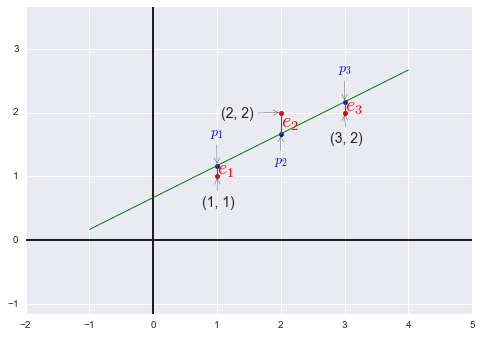第十六讲:投影矩阵和最小二乘
第十六讲:投影矩阵和最小二乘
上一讲中,我们知道了投影矩阵$P=A(A^TA)^{-1}A^T$,$Pb$将会把向量投影在$A$的列空间中。
举两个极端的例子:
- 如果$b\in C(A)$,则$Pb=b$;
- 如果$b\bot C(A)$,则$Pb=0$。
一般情况下,$b$将会有一个垂直于$A$的分量,有一个在$A$列空间中的分量,投影的作用就是去掉垂直分量而保留列空间中的分量。
在第一个极端情况中,如果$b\in C(A)$则有$b=Ax$。带入投影矩阵$p=Pb=A(A^TA)^{-1}A^TAx=Ax$,得证。
在第二个极端情况中,如果$b\bot C(A)$则有$b\in N(A^T)$,即$A^Tb=0$。则$p=Pb=A(A^TA)^{-1}A^Tb=0$,得证。
向量$b$投影后,有$b=e+p, p=Pb, e=(I-P)b$,这里的$p$是$b$在$C(A)$中的分量,而$e$是$b$在$N(A^T)$中的分量。
回到上一讲最后提到的例题:
我们需要找到距离图中三个点 $(1, 1), (2, 2), (3, 2)$ 偏差最小的直线:$y=C+Dt$。
%matplotlib inline
import matplotlib.pyplot as plt
from sklearn import linear_model
import numpy as np
import pandas as pd
import seaborn as sns
x = np.array([1, 2, 3]).reshape((-1,1))
y = np.array([1, 2, 2]).reshape((-1,1))
predict_line = np.array([-1, 4]).reshape((-1,1))
regr = linear_model.LinearRegression()
regr.fit(x, y)
ey = regr.predict(x)
fig = plt.figure()
plt.axis('equal')
plt.axhline(y=0, c='black')
plt.axvline(x=0, c='black')
plt.scatter(x, y, c='r')
plt.scatter(x, regr.predict(x), s=20, c='b')
plt.plot(predict_line, regr.predict(predict_line), c='g', lw='1')
[ plt.plot([x[i], x[i]], [y[i], ey[i]], 'r', lw='1') for i in range(len(x))]
plt.annotate('(1, 1)', xy=(1, 1), xytext=(-15, -30), textcoords='offset points', size=14, arrowprops=dict(arrowstyle="->"))
plt.annotate('(2, 2)', xy=(2, 2), xytext=(-60, -5), textcoords='offset points', size=14, arrowprops=dict(arrowstyle="->"))
plt.annotate('(3, 2)', xy=(3, 2), xytext=(-15, -30), textcoords='offset points', size=14, arrowprops=dict(arrowstyle="->"))
plt.annotate('$e_1$', color='r', xy=(1, 1), xytext=(0, 2), textcoords='offset points', size=20)
plt.annotate('$e_2$', color='r', xy=(2, 2), xytext=(0, -15), textcoords='offset points', size=20)
plt.annotate('$e_3$', color='r', xy=(3, 2), xytext=(0, 1), textcoords='offset points', size=20)
plt.annotate('$p_1$', xy=(1, 7/6), color='b', xytext=(-7, 30), textcoords='offset points', size=14, arrowprops=dict(arrowstyle="->"))
plt.annotate('$p_2$', xy=(2, 5/3), color='b', xytext=(-7, -30), textcoords='offset points', size=14, arrowprops=dict(arrowstyle="->"))
plt.annotate('$p_3$', xy=(3, 13/6), color='b', xytext=(-7, 30), textcoords='offset points', size=14, arrowprops=dict(arrowstyle="->"))
plt.draw()
plt.close(fig)根据条件可以得到方程组
$
\begin{cases}
C+D&=1 \
C+2D&=2 \
C+3D&=2 \
\end{cases}
$,写作矩阵形式
$\begin{bmatrix}1&1 \1&2 \1&3\\end{bmatrix}\begin{bmatrix}C\D\\end{bmatrix}=\begin{bmatrix}1\2\2\\end{bmatrix}$,也就是我们的$Ax=b$,很明显方程组无解。
我们需要在$b$的三个分量上都增加某个误差$e$,使得三点能够共线,同时使得$e_1^2+e_2^2+e_3^2$最小,找到拥有最小平方和的解(即最小二乘),即$\left|Ax-b\right|^2=\left|e\right|^2$最小。此时向量$b$变为向量$p=\begin{bmatrix}p_1\p_2\p_3\end{bmatrix}\$(在方程组有解的情况下,$Ax-b=0$,即$b$在$A$的列空间中,误差$e$为零。)我们现在做的运算也称作线性回归(linear regression),使用误差的平方和作为测量总误差的标准。
注:如果有另一个点,如$(0, 100)$,在本例中该点明显距离别的点很远,最小二乘将很容易被离群的点影响,通常使用最小二乘时会去掉明显离群的点。
现在我们尝试解出$\hat x=\begin{bmatrix}\hat C\ \hat D\end{bmatrix}$与$p=\begin{bmatrix}p_1\p_2\p_3\end{bmatrix}$。
$$
A^TA\hat x=A^Tb\
A^TA=
\begin{bmatrix}3&6\6&14\end{bmatrix}\qquad
A^Tb=
\begin{bmatrix}5\11\end{bmatrix}\
\begin{bmatrix}3&6\6&14\end{bmatrix}
\begin{bmatrix}\hat C\\hat D\end{bmatrix}=
\begin{bmatrix}5\11\end{bmatrix}\
$$
写作方程形式为$\begin{cases}3\hat C+16\hat D&=5\6\hat C+14\hat D&=11\\end{cases}$,也称作正规方程组(normal equations)。
回顾前面提到的“使得误差最小”的条件,$e_1^2+e_2^2+e_3^2=(C+D-1)^2+(C+2D-2)^2+(C+3D-2)^2$,使该式取最小值,如果使用微积分方法,则需要对该式的两个变量$C, D$分别求偏导数,再令求得的偏导式为零即可,正是我们刚才求得的正规方程组。(正规方程组中的第一个方程是对$C$求偏导的结果,第二个方程式对$D$求偏导的结果,无论使用哪一种方法都会得到这个方程组。)
解方程得$\hat C=\frac{2}{3}, \hat D=\frac{1}{2}$,则“最佳直线”为$y=\frac{2}{3}+\frac{1}{2}t$,带回原方程组解得$p_1=\frac{7}{6}, p_2=\frac{5}{3}, p_3=\frac{13}{6}$,即$e_1=-\frac{1}{6}, e_2=\frac{1}{3}, e_3=-\frac{1}{6}$
于是我们得到$p=\begin{bmatrix}\frac{7}{6}\\frac{5}{3}\\frac{13}{6}\end{bmatrix}, e=\begin{bmatrix}-\frac{1}{6}\\frac{1}{3}\-\frac{1}{6}\end{bmatrix}$,易看出$b=p+e$,同时我们发现$p\cdot e=0$即$p\bot e$。
误差向量$e$不仅垂直于投影向量$p$,它同时垂直于列空间,如 $\begin{bmatrix}1\1\1\end{bmatrix}, \begin{bmatrix}1\2\3\end{bmatrix}$。
接下来我们观察$A^TA$,如果$A$的各列线性无关,求证$A^TA$是可逆矩阵。
先假设$A^TAx=0$,两边同时乘以$x^T$有$x^TA^TAx=0$,即$(Ax)^T(Ax)=0$。一个矩阵乘其转置结果为零,则这个矩阵也必须为零($(Ax)^T(Ax)$相当于$Ax$长度的平方)。则$Ax=0$,结合题设中的“$A$的各列线性无关”,可知$x=0$,也就是$A^TA$的零空间中有且只有零向量,得证。
我们再来看一种线性无关的特殊情况:互相垂直的单位向量一定是线性无关的。
- 比如$\begin{bmatrix}1\0\0\end{bmatrix}\begin{bmatrix}0\1\0\end{bmatrix}\begin{bmatrix}0\0\1\end{bmatrix}$,这三个正交单位向量也称作标准正交向量组(orthonormal vectors)。
- 另一个例子$\begin{bmatrix}\cos\theta\\sin\theta\end{bmatrix}\begin{bmatrix}-\sin\theta\\cos\theta\end{bmatrix}$
下一讲研究标准正交向量组。
